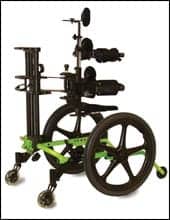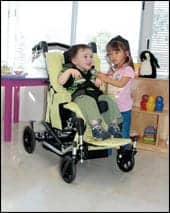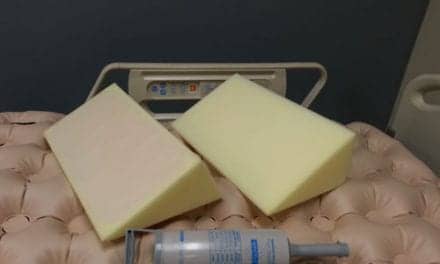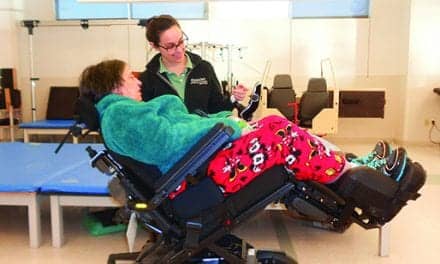 |
| A variety of partial weight-bearing systems are available to get young clients up and moving. |
Mobility can make kids smarter. Children who move independently through space score higher on tests of cognition (mostly visual skills). In fact, recent studies by Kermoian, Campos, Bell, and Fox1,2 looked at infants who were at the same developmental level and chronological age—those who used augmentative mobility did better on tests of object permanence.
Another group of studies by Ulrich et al3 showed that infants with Down syndrome who were taught to walk early using treadmills did better on tests of receptive language, while a paper by Angulo-Barroso et al4 demonstrates that when children gain independent mobility for the first time through power mobility, they also score higher on tests of cognition. Additional research by Mazur et al5 on children with spina bifida showed that those who walked for a brief period of time—even if they did not continue to do so—were more likely to be able to transfer and catheterize themselves, than if they had not.
As more evidence suggests that children who are given augmentative mobility before age 2 do better in many areas of function, why wait? If a child already has delays, are we not compounding them by allowing the child to remain stationary and lose out on opportunities to explore and interact with the environment? This article discusses several tools that pediatric therapists can use to get the little ones mobile—and maybe even smarter! There is so much to cover, so let me start with my favorite must haves:
HANDS-FREE DYNAMIC MOBILITY SYSTEM
California-based occupational therapist Chris Wright and her engineer associate, Richard Escobar, have developed KidWalk by Prime Engineering, a hands-free dynamic mobility system—a gait trainer designed with more features than a Hummer. This dynamic system goes up and down, side to side, and even swivels. All the adjustments are tool-free and can be made with the child in the device. In addition, it is made to grow from teeny weeny to teenager, and enables the child to get up close and personal with toys and friends. If you are looking for a way to jump-start exploration and mobility, this may be your best pick.
DYNAMIC, PARTIAL WEIGHT-BEARING SUPPORT
The Up-N-Go Walker gait trainer, offered by Easy Walking, Maple Glen, Pa, has been around a while, but keeps getting upgrades, additions, and improvements—and is just plain better than ever. This is the only gait trainer on the market that enables the child to go from sit to stand and half kneel to stand, and does not allow them to “hang.” If you have a child who is “sitting” in their current gait trainer—and you just know they have the ability to walk, or if you predict that the child will be an independent walker and you want them to learn to “push down to stand up”—then this gait trainer is worth a try.
Notes From a Case: One of my clients, Clyde, was born with all of his major organs on the wrong side of his body, and only one lung. He was expected to live only a few months. After his first birthday, his attending medical team decided he could begin therapy. Clyde was able to sit on his own, but not roll, crawl, stand, or get in and out of sitting. He also had a tracheotomy, but was otherwise healthy. We began teaching him to walk using the Up-N-Go Walker. This device was so versatile that Clyde could get up and down from the floor through half kneel. He learned to get around in a few short weeks and, after just 2 months, took his first independent steps.
 |
| An experienced team can help determine the best system to suit the individual needs of a young client. |
CHILDREN’S POWER WHEELCHAIR
Skippi, by Otto Bock, Minneapolis, is a new pediatric power chair that is different from the rest of the pack, as its sleek design makes you look twice to even notice that it has power.
The wheelchair’s footprint is small and the base is open, so you can look right down and see the ground. This is perfect for little kids who often get overshadowed by their equipment. It has tilt and recline, and breaks down easily for transport in the car trunk. Right now, it can be driven only with a joystick, but very soon there should be a head array option, with more options to follow. Additionally, this chair is the only pediatric power chair that has passed RESNA WC-19 crash-testing, and its tie-down anchor points have been integrated into the design of the frame for added convenience. Kudos to Otto Bock for going through the process of crash testing and passing WC19. Little kids often ride in their wheelchairs on the school bus, so it is imperative that the bases have been shown to be crash worthy. Kids should still be transported in car seats with five-point harnesses up to 8 years of age AND 80 pounds. Once they are transported in a vehicle in their wheelchair, make sure that they have a head rest behind their head and they use the vehicle seat belt. Ask for the transport option when you order the chair so all the hardware will also be crash tested.
EARLY INTERVENTION WHEELCHAIR
The Cuddlebug, designed by Convaid, Torrance, Calif, offers a system for kids and moms (hence the cup holder). The unit goes flat for diaper changes, and all the hardware is covered (and the child protected) by fabric imprinted with images of cute puppies. The entire base goes up and down (high/low), and it has tilt and recline. This system certainly meets the criteria of “universal design” in that every mother would be proud to walk down Main Street with their child in this system.
More Case Notes: Fifteen-month-old Sam was the product of a “normal” full-term pregnancy. His mother is a psychologist and received all the recommended prenatal care, but somehow, Sam was born not breathing (Apgars 0 and 0) and took a full 32 minutes before he was able to breathe on his own. Nowadays, Sam prefers to move using full extension, and just started tracking (with his eyes) and reaching. He is not wild about turning his head past midline. He cannot sit or roll but can push up on extended elbows in prone. His parents are still hoping he will be okay, and are not ready for positioning equipment at home. They are excited about using body weight support treadmill training and have just started using a gait trainer at home.
At day care, Sam uses the Rifton prone stander, a Jenx Ladybug, and a Leckey Early Activity System. In addition, Sam has already begun power mobility training in Innovative Products Inc’s GoBot, a mini supine stander that enables special needs children to achieve a certain modicum of mobility. We use this to get cause and effect—you push the switch and something wonderful happens—and all your senses are stimulated!
Because Sam’s parents are not yet ready to hear about seating and positioning issues, they will only accept something that looks like regular baby equipment, and the Cuddlebug is perfect.
TEENY WEENY ULTRALIGHTS
Why wait until the child has shoulder pain to justify an ultralight high-performance chair? Experts tell us that repetitive stress syndrome, carpal tunnel syndrome, and shoulder pain occur in 85% of manual wheelchair users over their life span. Some anecdotal information suggests that if we get really young kids pushing manual chairs, their shoulder bones, muscles, ligaments, and the entire joint structure form differently. This “super” shoulder forms under stress and so functions better under stress. Could it be that these ultra-young pushers will be spared pain and injury because of their early exposure to self-propulsion? Only further research will tell, but it’s just one more reason to get kids mobile before age 2!
KEEP IN THE LOOP AND STAY ON TOP!
Competitive bidding and pressure to reduce spending on Medicare are driving more rehabilitation professionals to expand into pediatrics. Make sure your team is experienced and up to date on the latest pediatrics issues, as well as knowledgeable about all the latest innovations in mobility options. Also, make it a point to attend as many national and international trade shows and conferences (and local expositions) as your schedule will allow, in an effort to remain abreast of the ever-increasing variety of pediatric health and mobility products available within the marketplace. In addition, I encourage you and your staff to constantly expand your knowledge of the industry, by taking advantage of the plethora of information and education sources available online. A variety of Webinars, podcasts, and more are on the Web for a relatively low cost—and sometimes free—to enhance your knowledge, as well as meet the requirements for those necessary CEUs. These days, the important thing for all of us is to remain informed.
Ginny S. Paleg, MS, PT, is an NDT-certified pediatric physical therapist and a University of Maryland doctoral candidate, Silver Spring, Md. She is the APTA representative for pediatric section reimbursement, a Listserv monitor, and CEU instructor. Paleg also serves on the editorial advisory board of Rehab Management. She can be reached at .
REFERENCES
- Kermoian R, Campos JJ. Locomotor experience: a facilitator of spatial cognitive development. Child Dev. 1988;59(4):908-17.
- Bell MA, Fox NA. Individual differences in object permanence performance at 8 months: locomotor experience and brain electrical activity. Dev Psychobiol. 1997;31(4):287-97.
- Ulrich DA, Ulrich BD, Angulo-Kinzler RM, Yun J. Treadmill training of infants with Down syndrome: evidence-based developmental outcomes. Pediatrics. 2001;108(5):E84.
- Angulo-Barroso RM, Wu J, Ulrich DA Long-term effect of different treadmill interventions on gait development in new walkers with Down syndrome. Gait Posture. 2007;27(2):231-8.
- Mazur JM, Shurtleff D, Menelaus M, Colliver J. Orthopaedic management of high-level spina bifida. Early walking compared with early use of a wheelchair. J Bone Joint Surg Am. 1989;71(1):56-61.





